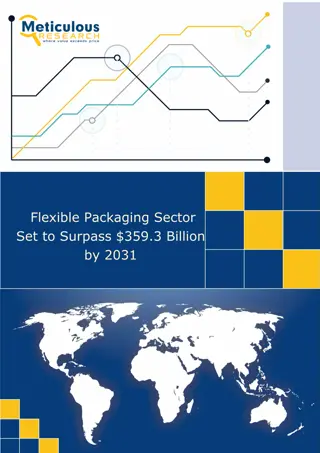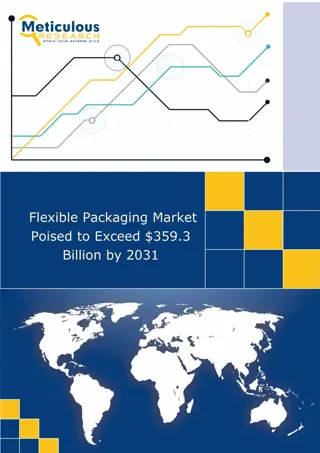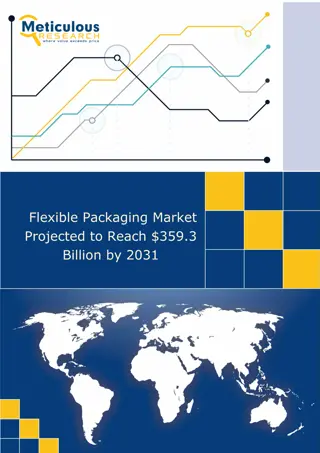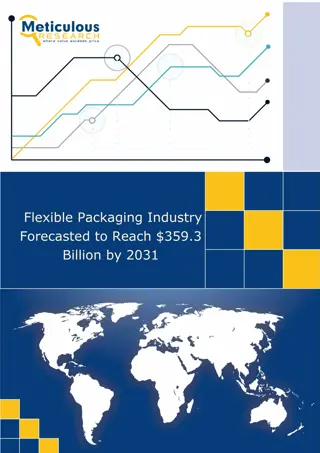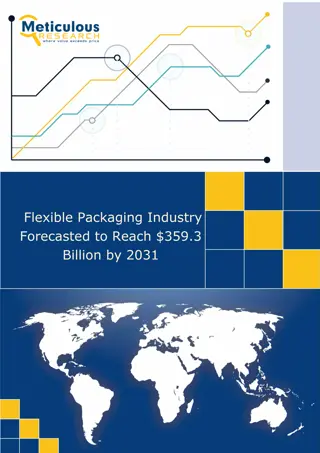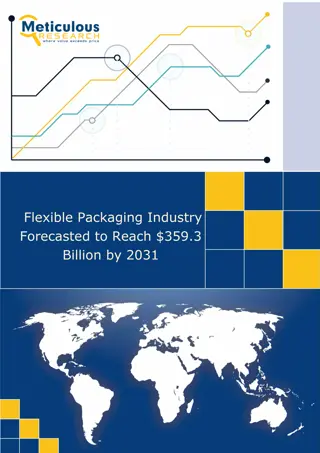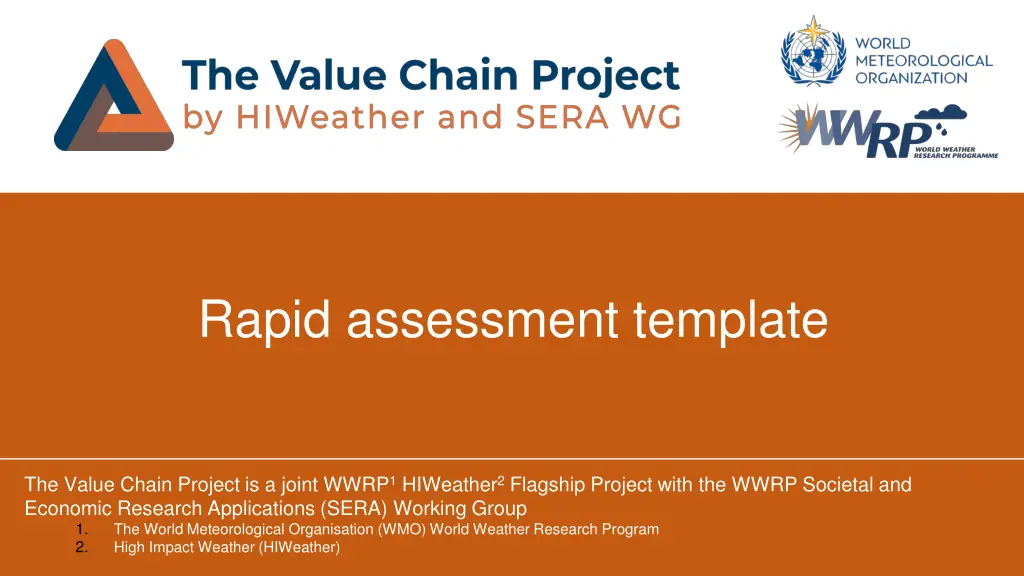
Value Chain Project by HIWeather and SERA WG: Rapid Assessment Template
Explore the collaborative effort of the WWRP HIWeather and WMO SERA WG in the Value Chain Project, aimed at enhancing high impact weather warnings. This template facilitates rapid assessments along the warning value chain to improve future warning practices.
Download Presentation

Please find below an Image/Link to download the presentation.
The content on the website is provided AS IS for your information and personal use only. It may not be sold, licensed, or shared on other websites without obtaining consent from the author. If you encounter any issues during the download, it is possible that the publisher has removed the file from their server.
You are allowed to download the files provided on this website for personal or commercial use, subject to the condition that they are used lawfully. All files are the property of their respective owners.
The content on the website is provided AS IS for your information and personal use only. It may not be sold, licensed, or shared on other websites without obtaining consent from the author.
E N D
Presentation Transcript
Rapid assessment template The Value Chain Project is a joint WWRP1HIWeather2Flagship Project with the WWRP Societal and Economic Research Applications (SERA) Working Group 1. The World Meteorological Organisation (WMO) World Weather Research Program 2. High Impact Weather (HIWeather) The Value Chain Project By HIWeather and SERA WG
Contents Introduction to the warning value chain Rapid assessment template 1. Essential information 2. Observations 3. Weather forecasts 4. Hazard forecasts 5. Impact forecasts 6. Warning communication 7. Warning response 8. Analysis of the warning chain 9. Subjective scoring (could be done as a group activity) Add key evidence for the different value chain components (e.g., copy and paste content from observations, forecast displays and warnings) and include any comments or thoughts you have on this evidence. The Value Chain Project By HIWeather and SERA WG
Introduction to the warning value chain This section covers a brief introduction to the warning value chain and warning value chain questionnaire. The Value Chain Project By HIWeather and SERA WG
The warning value chain This simplified view of the value chain for high impact weather warnings shows the capabilities and outputs (green "mountains ) where value is added, and information exchanges (bridges crossing the valleys of death where value is lost) linking the capabilities and their associated communities. From Golding (2022). The Value Chain Project By HIWeather and SERA WG
Full questionnaire First developed by WMO/WWRP s HIWeather Warning Value Chain Flagship Project in 2021. Designed to help capture the end-to-end production and flow of information and decision making along the warning chain. Completed questionnaires add to a global database of hazardous weather events. Supports learning from past events to: Help understand effective practices. Identify improvements that would enhance future warnings. Full questionnaires can be downloaded from Google Drive Google doc - https://docs.google.com/document/d/1tWx9TrMols0BUPwHzB mVynJIWx31Vgo5fMLe23OCRvw/edit?usp=drive_link MS Word (zip) - https://drive.google.com/file/d/1PGRxIRtC976lscDcbMezFV36 6suZ0xhB/view?usp=drive_link The Value Chain Project By HIWeather and SERA WG
Rapid assessment questionnaire The rapid assessment template contained in the following slides is not designed to replace the full questionnaire template, but instead may help with: Rapid assessments where there is not time to complete a full questionnaire. Storing perishable and/or key information until a time comes to complete a full questionnaire. Presenting key results from a fully completed questionnaire. The Value Chain Project By HIWeather and SERA WG
1. Essential information Brief facts about the particular event: What happened? When? Where? Overview of warnings, responses and impacts The Value Chain Project By HIWeather and SERA WG
Essential information The Value Chain Project By HIWeather and SERA WG
2. Observations For example: Observational data used in the weather forecasts Weather observations and analysis charts How did the observed weather relate to climatology and/or previous extreme events Successes/issues/challenges experienced The Value Chain Project By HIWeather and SERA WG
Observations The Value Chain Project By HIWeather and SERA WG
3. Weather forecasts For example: Weather forecast models used in this event Post-processing/calibration applied to weather model output Weather forecast outputs and examples Interpretation/guidance for forecast users Level of agreement between the different forecasts How reliable and accurate were weather forecasts at different lead times? When was the potential event first detected in the models? Successes/issues/challenges experienced The Value Chain Project By HIWeather and SERA WG
Weather forecasts The Value Chain Project By HIWeather and SERA WG
4. Hazard forecasts For example: Hazard forecast outputs and examples How reliable and accurate were the hazard forecasts What process identified the event as hazardous and started the warning process? Hazard observations and analyses How was the hazard(s) made worse by pre-existing conditions? Successes/issues/challenges experienced The Value Chain Project By HIWeather and SERA WG
Hazard forecasts The Value Chain Project By HIWeather and SERA WG
5. Impact forecasts For example: Impact prediction models/tools (if used) Informal rules/tools used to predict impacts Impact forecast outputs and examples Who and what were exposed and vulnerable to the hazards? Observed impacts e.g health/social, property/business, infrastructure, environmental Comparison of predicted/expected and actual impacts Successes/issues/challenges experienced The Value Chain Project By HIWeather and SERA WG
Impact forecasts The Value Chain Project By HIWeather and SERA WG
6. Warning communication For example: Brief overview of the communication story What warnings were provided to emergency responders, stakeholders and the public? Communication of warning information by other organizations including media Warning outputs and examples, including uncertainty information Were communication systems in place and operating effectively? To what extent were warning messages received and understood by the public? Communication success/issues/challenges experienced The Value Chain Project By HIWeather and SERA WG
Warning communication The Value Chain Project By HIWeather and SERA WG
7. Warning response For example: Overview of response to warnings by emergency services, the public, and institutions? How did the response compare to similar previous events? Were disaster preparedness and response plans used? How did key decision makers and institutions interact before, during and after event? How knowledgeable was the community about the hazard and its associated risks? What capacity did the community have to respond to warnings? Success/issues/challenges experienced The Value Chain Project By HIWeather and SERA WG
Warning response The Value Chain Project By HIWeather and SERA WG
8. Analysis of the warning chain For example: Evidence that warning chain was effective in reducing impacts What were the strongest links (information flow) in the warning chain? What were the weakest links (information flow) in the warning chain? Are there any key lessons learned from this event? The Value Chain Project By HIWeather and SERA WG
Analysis of the warning chain The Value Chain Project By HIWeather and SERA WG
9. Scoring How successful were the forecasts, warnings and responses? The Value Chain Project By HIWeather and SERA WG
Scoring Scale of 1 (poor) to 5 (excellent). Score individually and then take a group average. Note any justification for your scores on the subsequent slides. Person A Person B Person C Person D Person E Average How well do you think the event was observed? How well do you think the weather was forecast? How well do you think the hazards were forecast? How well do you think the impacts were predicted? How well do you think warnings were communicated? How well do you think the warnings were used? How well do you think the entire warning chain performed overall? The Value Chain Project By HIWeather and SERA WG
Person A score justification Scores Justification How well do you think the event was observed? How well do you think the weather was forecast? How well do you think the hazards were forecast? How well do you think the impacts were predicted? How well do you think warnings were communicated? How well do you think the warnings were used? How well do you think the entire warning chain performed overall? The Value Chain Project By HIWeather and SERA WG
Person B score justification Scores Justification How well do you think the event was observed? How well do you think the weather was forecast? How well do you think the hazards were forecast? How well do you think the impacts were predicted? How well do you think warnings were communicated? How well do you think the warnings were used? How well do you think the entire warning chain performed overall? The Value Chain Project By HIWeather and SERA WG
Person C score justification Scores Justification How well do you think the event was observed? How well do you think the weather was forecast? How well do you think the hazards were forecast? How well do you think the impacts were predicted? How well do you think warnings were communicated? How well do you think the warnings were used? How well do you think the entire warning chain performed overall? The Value Chain Project By HIWeather and SERA WG
Person D score justification Scores Justification How well do you think the event was observed? How well do you think the weather was forecast? How well do you think the hazards were forecast? How well do you think the impacts were predicted? How well do you think warnings were communicated? How well do you think the warnings were used? How well do you think the entire warning chain performed overall? The Value Chain Project By HIWeather and SERA WG
Person E score justification Scores Justification How well do you think the event was observed? How well do you think the weather was forecast? How well do you think the hazards were forecast? How well do you think the impacts were predicted? How well do you think warnings were communicated? How well do you think the warnings were used? How well do you think the entire warning chain performed overall? The Value Chain Project By HIWeather and SERA WG
Scoring summary The Value Chain Project By HIWeather and SERA WG
Key notes / recommendations The Value Chain Project By HIWeather and SERA WG
More information HIWeather warning value chain project website (June 2023) Full warning value chain questionnaire (July 2023) Golding (2022) Towards the Perfect Weather Warning: Bridging Disciplinary Gaps through Partnership and Communication. Available from https://link.springer.com/book/10.1007/978-3-030-98989-7. Hoffmann, D., E.E. Ebert, C. Mooney, B. Golding and S. Potter (2023) Using value chain approaches to evaluate the end-to-end warning chain. Adv. Sci. Res., 20, 73 79, https://doi.org/10.5194/asr-20-73-2023. WMO WWRP website (July 2023) Email: valuechain@bom.gov.au The Value Chain Project By HIWeather and SERA WG





